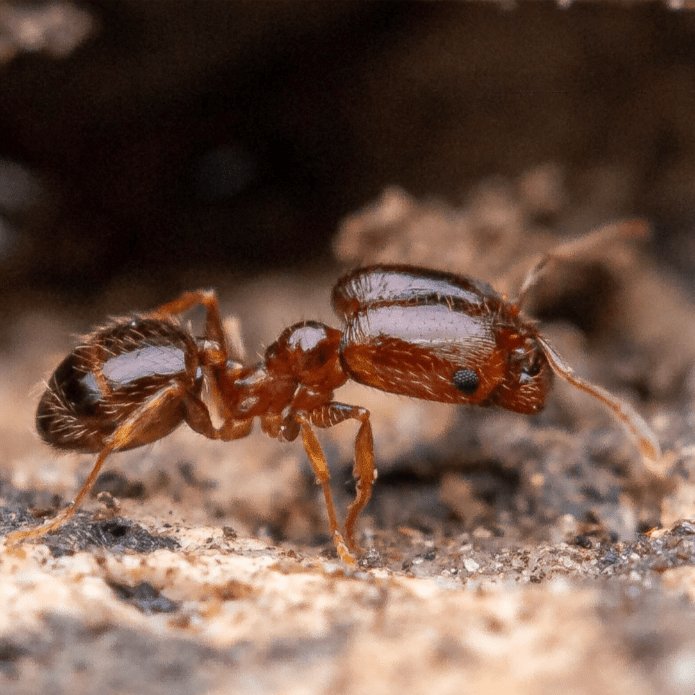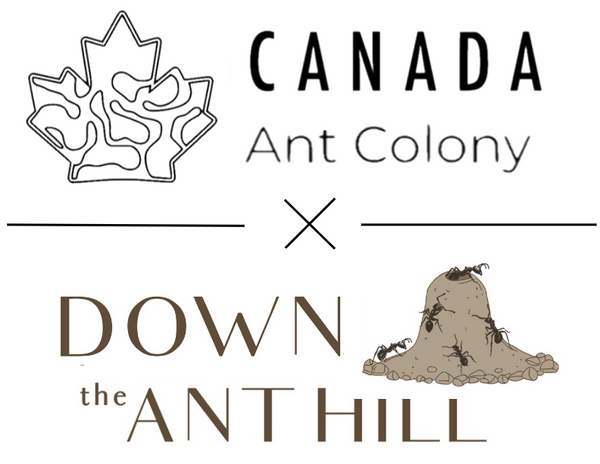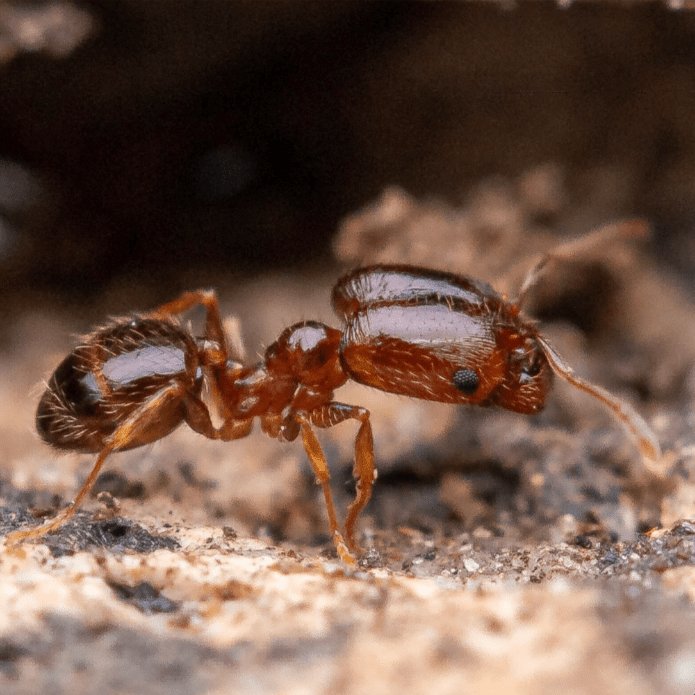Canada Ant Colony
Pheidole californica (Californian Big-headed Ant)
Pheidole californica (Californian Big-headed Ant)
Couldn't load pickup availability
These colonies are polygynous. If you would like multi-queen colonies, buy multiple colonies and specify you want them together in the order comments
Located in just a short strip of land in the Okanagan Valley, Pheidole californica is one of very few native Canadian big headed ant species. They’re notable for their strong polymorphism, having small minors and large majors with massive bulky heads. In the wild, minors will collect insect parts and seeds. Majors will then process these into smaller parts for the larvae to be able to eat. Excess seeds will be stored for harder times. Minors will occasionally also collect sugars, and majors will opportunistically try to take down live prey. They will also serve as a source of protection for the colony. Colonies have many queens, and in nature will often break off and move around. A colony's size is largely determined by the number of queens, with smaller single queen colonies having less than a few hundred workers at maturity, and larger dozen queen colonies having thousands of workers.
Pheidole californica are in the pilifera group, a group largely consisting of harvester ants. Workers and queens are red and small, with minors at 2 mm, majors at 4 mm, and queens at 6 mm. They do not need to diapause.
Care for this species is very simple. With some heat, humidity, lots of seeds and protein, they'll grow very fast. Due to their granivorous nature, depending on if they have enough seeds and water they can survive a very long time without care, however they won’t thrive without protein.
Wild pictures come from Josiah Kilburn :)
| Scientific Name: |
Pheidole californica
|
| Common Name: |
Californian Big-headed Ant
|
| Taxonomy: |
Kingdom: Animalia | Phylum: Arthropoda | Class: Insecta | Order: Hymenoptera | Family: Formicidae | Subfamily: Myrmeicinae | Genus: Pheidole | Species: P. californica
|
| Care Difficulty: |
Pheidole californica is a beginner level species.
|
| Distribution: |
This species can only be found in 3 countries, Canada, USA, and Mexico, in the most western parts of them. They're found from Central America north to just barely reaching into British Columbia, where they're found in very arid climates.
|
| Habitat: |
This species can be found in areas with arid conditions. They have been recorded to live in areas with sandy soils. Colonies have also been observed to nest in soil with high clay content.
|
| Colony form: |
This species is polygynous meaning that a colony can have multiple queens.
|
| Queen: |
Queens of this species reach a size of around 6 mm.
|
| Worker: |
Pheidole californica workers are able to grow to around 2 mm.
|
| Soldier: |
Like all species of Pheidole, this species has majors (also known as soldiers). Majors of this species will range anywhere from 4 mm.
|
| Males: |
Pheidole californica males are 3-4mm.
|
| Nutrition: |
Pheidole californica will eat almost anything. They will easily take most carbohydrates without issue, this includes: seeds, nuts, honey, sugar water, honey water, and sunburst ant nectar. They're largely granivorous, so when it comes to carbs seeds should be your first pick. When it comes to proteins, Pheidole californica will take almost any protein source most feeder insects such as, fruit flies, crickets, mealworms, superworms, surinam roaches, and discoid roaches. It is generally recommended to feed larger prey items pre-killed because of their small worker sizes. Colonies will most likely have issues taking down large prey items.
|
| Air humidity: |
Pheidole californica should be kept at humidity levels around 65%.
|
| Temperature: |
This species is thermophilic. It is recommended to keep colonies above 28C for optimal growth.
|
| Hibernation: |
Hibernation is not needed nor recommended for this species. Colonies can grow all year long.
|
| Nesting Habits: |
In the wild they have been observed to nest in sandy soil under objects such as wood, rocks, and other cover.
|
| Kind of Formicaria: |
Pheidole californica will do well in most formicaria except it is recommended to avoid wood nests. Colonies will do well in any Tarheel ants, Por Amor, and Buckeye Myrmecology nest. Due to their small size, it is recommended to keep them in a nest with tight fitting glass to prevent escapes.
|
| Formicaria size: |
Colonies will often stay relatively small maxing out at a few thousand workers. Due to their small size, colonies can be kept in a small formicarium for the majority of their life.
|
| Description: |
Pheidole californica is an amazing beginner species perfect for someone who is looking for an entertaining desk top ant species. Due to their small size, they can be kept in small formicaria making them not take up a lot of space. Colonies will swarm food making it very entertaining to watch as you see large headed soldiers and smaller sized workers consume and break down their food.
|
| Development: |
Colonies will have their nuptial flights during April, May, and June, primarily with high humidity and heat.
|
| Offering quantity: |
Queen, Queen + 1-5 workers, Queen + 5-10 workers, Queen + 10-25 workers, Queen + 25-50 workers, Queen + 50-100 workers.
|
| Weblinks: |
Shipping Conditions
This species comes from more warm areas than Canada, and are not cold-tolerant. Thus, we will not ship them in the winter
Just a warning, we will NOT ship live ants into the US unless the receiver has a permit. If such an order is made, it will be refunded, minus a 10% processing fee and restocking fee
This product is from Canada Ant Colony. The full catalogue, including all variants, can be found at https://canada-ant-colony.com
For US Ant Keepers
We can't ship live ants to the US, but we've partnered with Stateside Ants to help spread ant keeping. They're a highly reputable ant store and ship to all states in the lower 48. You can check them out here and use code DTAHAFFIL for 10% off
Share

- Description
- Shipping Conditions
- For US Ant Keepers
- Reviews
These colonies are polygynous. If you would like multi-queen colonies, buy multiple colonies and specify you want them together in the order comments
Located in just a short strip of land in the Okanagan Valley, Pheidole californica is one of very few native Canadian big headed ant species. They’re notable for their strong polymorphism, having small minors and large majors with massive bulky heads. In the wild, minors will collect insect parts and seeds. Majors will then process these into smaller parts for the larvae to be able to eat. Excess seeds will be stored for harder times. Minors will occasionally also collect sugars, and majors will opportunistically try to take down live prey. They will also serve as a source of protection for the colony. Colonies have many queens, and in nature will often break off and move around. A colony's size is largely determined by the number of queens, with smaller single queen colonies having less than a few hundred workers at maturity, and larger dozen queen colonies having thousands of workers.
Pheidole californica are in the pilifera group, a group largely consisting of harvester ants. Workers and queens are red and small, with minors at 2 mm, majors at 4 mm, and queens at 6 mm. They do not need to diapause.
Care for this species is very simple. With some heat, humidity, lots of seeds and protein, they'll grow very fast. Due to their granivorous nature, depending on if they have enough seeds and water they can survive a very long time without care, however they won’t thrive without protein.
Wild pictures come from Josiah Kilburn :)
| Scientific Name: | Pheidole californica |
| Common Name: | Californian Big-headed Ant |
| Taxonomy: | Kingdom: Animalia | Phylum: Arthropoda | Class: Insecta | Order: Hymenoptera | Family: Formicidae | Subfamily: Myrmeicinae | Genus: Pheidole | Species: P. californica |
| Care Difficulty: | Pheidole californica is a beginner level species. |
| Distribution: | This species can only be found in 3 countries, Canada, USA, and Mexico, in the most western parts of them. They're found from Central America north to just barely reaching into British Columbia, where they're found in very arid climates. |
| Habitat: | This species can be found in areas with arid conditions. They have been recorded to live in areas with sandy soils. Colonies have also been observed to nest in soil with high clay content. |
| Colony form: | This species is polygynous meaning that a colony can have multiple queens. |
| Queen: | Queens of this species reach a size of around 6 mm. |
| Worker: | Pheidole californica workers are able to grow to around 2 mm. |
| Soldier: | Like all species of Pheidole, this species has majors (also known as soldiers). Majors of this species will range anywhere from 4 mm. |
| Males: | Pheidole californica males are 3-4mm. |
| Nutrition: | Pheidole californica will eat almost anything. They will easily take most carbohydrates without issue, this includes: seeds, nuts, honey, sugar water, honey water, and sunburst ant nectar. They're largely granivorous, so when it comes to carbs seeds should be your first pick. When it comes to proteins, Pheidole californica will take almost any protein source most feeder insects such as, fruit flies, crickets, mealworms, superworms, surinam roaches, and discoid roaches. It is generally recommended to feed larger prey items pre-killed because of their small worker sizes. Colonies will most likely have issues taking down large prey items. |
| Air humidity: | Pheidole californica should be kept at humidity levels around 65%. |
| Temperature: | This species is thermophilic. It is recommended to keep colonies above 28C for optimal growth. |
| Hibernation: | Hibernation is not needed nor recommended for this species. Colonies can grow all year long. |
| Nesting Habits: | In the wild they have been observed to nest in sandy soil under objects such as wood, rocks, and other cover. |
| Kind of Formicaria: | Pheidole californica will do well in most formicaria except it is recommended to avoid wood nests. Colonies will do well in any Tarheel ants, Por Amor, and Buckeye Myrmecology nest. Due to their small size, it is recommended to keep them in a nest with tight fitting glass to prevent escapes. |
| Formicaria size: | Colonies will often stay relatively small maxing out at a few thousand workers. Due to their small size, colonies can be kept in a small formicarium for the majority of their life. |
| Description: | Pheidole californica is an amazing beginner species perfect for someone who is looking for an entertaining desk top ant species. Due to their small size, they can be kept in small formicaria making them not take up a lot of space. Colonies will swarm food making it very entertaining to watch as you see large headed soldiers and smaller sized workers consume and break down their food. |
| Development: | Colonies will have their nuptial flights during April, May, and June, primarily with high humidity and heat. |
| Offering quantity: | Queen, Queen + 1-5 workers, Queen + 5-10 workers, Queen + 10-25 workers, Queen + 25-50 workers, Queen + 50-100 workers. |
| Weblinks: | https://www.antwiki.org/wiki/Pheidole_californica |
This species comes from more warm areas than Canada, and are not cold-tolerant. Thus, we will not ship them in the winter
Just a warning, we will NOT ship live ants into the US unless the receiver has a permit. If such an order is made, it will be refunded, minus a 10% processing fee and restocking fee
This product is from Canada Ant Colony. The full catalogue, including all variants, can be found at https://canada-ant-colony.com
We can't ship live ants to the US, but we've partnered with Stateside Ants to help spread ant keeping. They're a highly reputable ant store and ship to all states in the lower 48. You can check them out here and use code DTAHAFFIL for 10% off

